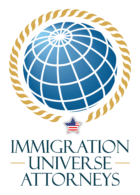¿Cómo calificar para una visa L1? – Todo lo que necesita hacer
Si su empresa necesita transferir a un gerente, ejecutivo o empleado con conocimientos especializados a una oficina en EE. UU., la visa L1 puede hacerlo posible. Esta visa ayuda a las empresas multinacionales a expandirse a Estados Unidos y permite a los empleados continuar sus carreras dentro de la misma organización.
En Immigration Universe Attorneys , ayudamos a empresas y profesionales a gestionar el proceso de la visa L1 con claridad y confianza. A continuación, encontrará una guía completa sobre cómo calificar para esta visa, qué documentos necesita y cómo evitar errores comunes que provocan denegaciones.
¿Qué es una visa L1 y quién puede solicitarla?
La visa L1 es una visa de no inmigrante que permite a las empresas internacionales transferir empleados calificados de sus oficinas en el extranjero a una sucursal, subsidiaria o afiliada en los Estados Unidos.
Hay dos categorías principales:
- Visa L1A: Para ejecutivos y gerentes que supervisan departamentos, equipos u operaciones de la empresa.
- Visa L1B: Para empleados que poseen conocimientos especializados esenciales para los servicios o productos de la empresa.
Para calificar, tanto las entidades estadounidenses como las extranjeras deben tener una relación calificada (empresa matriz, subsidiaria o afiliada), y el solicitante debe haber trabajado para la empresa en el extranjero durante al menos un año continuo dentro de los últimos tres años.
Ejemplo: Una empresa de tecnología en la Ciudad de México puede transferir a su gerente de proyecto a su oficina de Orlando bajo una visa L1A si ambas compañías comparten la propiedad y el control.
Requisitos de la visa L1: documentos y requisitos
Cumplir con los requisitos de elegibilidad es fundamental para una solicitud exitosa. La siguiente tabla describe los requisitos principales para cada tipo de visa.
| Requisito | L1A – Ejecutivos y gerentes | L1B – Empleados con conocimientos especializados |
| Historial laboral | Al menos un año continuo en un puesto ejecutivo o gerencial en el extranjero | Al menos un año continuo en un puesto de conocimiento especializado en el extranjero |
| Relación calificada | Empresa matriz, subsidiaria o afiliada entre empresas extranjeras y estadounidenses | El mismo requisito que L1A |
| Propósito en los EE.UU. | Gestionar o dirigir operaciones | Aplicar conocimientos especializados a las operaciones en EE. UU. |
| Documentación | Organigramas, comprobantes de empleo, registro mercantil, registros de nóminas | Descripción del puesto, documentación técnica, prueba de experiencia |
| Duración | Estancia inicial de hasta 3 años, renovable hasta 7 años | Estancia inicial de hasta 3 años, renovable hasta 5 años |
Consejo: Asegúrese siempre de que la documentación de la empresa muestre claramente la estructura de propiedad y la actividad comercial en ambos países. El USCIS revisa minuciosamente esta evidencia para confirmar una relación válida.
Proceso de visa L1 paso a paso
El proceso implica varias etapas y cada una de ellas requiere una preparación cuidadosa.
Paso 1: Confirmar la elegibilidad de la empresa
Verificar que la empresa estadounidense y su contraparte extranjera estén legalmente relacionadas y realicen negocios activamente.
Paso 2: Recopilar la documentación necesaria
Esto incluye cartas de verificación de empleo, registros financieros, gráficos de la empresa y documentos de constitución.
Paso 3: Presentar el Formulario I-129 (Petición para un Trabajador No Inmigrante)
El empleador debe presentar el Formulario I-129 y el Suplemento L al USCIS, junto con todos los documentos de respaldo.
Paso 4: Espere la decisión del USCIS
El plazo de tramitación estándar puede ser de uno a cinco meses. Sin embargo, el Tramitación Premium permite a los solicitantes recibir una decisión en un plazo de 15 días naturales.
Paso 5: Solicitar la visa en un consulado de EE. UU.
Si el empleado está fuera de los Estados Unidos, el siguiente paso es programar una entrevista en una embajada o consulado de Estados Unidos.
Paso 6: Ingrese y comience a trabajar en los EE. UU.
Una vez aprobado, el solicitante puede ingresar a los Estados Unidos y comenzar a trabajar bajo el estatus de visa L1.
Para obtener orientación legal completa durante todo este proceso, visite nuestra página principal de servicios: Servicios de Inmigración
Cómo aumentar sus posibilidades de aprobación
Una petición bien preparada es clave para el éxito. Aquí tienes consejos esenciales de la abogada Ileana Rivera y su equipo legal:
- Sea detallado con su documentación. Incluya organigramas, contratos de trabajo y perfiles de empresas que respalden su afirmación sobre la relación.
- Sea coherente. Asegúrese de que todos sus documentos (extranjeros y estadounidenses) coincidan en cuanto a cargos, nombres de empresas y datos de propiedad.
- Prepárese para posibles solicitudes de evidencia (RFE). El USCIS podría solicitar documentos adicionales, especialmente sobre funciones gerenciales o la estructura de la empresa.
- Trabaje con un abogado con experiencia en visas L1. La orientación profesional le ayudará a evitar errores que podrían retrasar o denegar su solicitud.
Visa L1 vs. otras visas basadas en empleo
Comprender cómo se compara la visa L1 con otras opciones puede ayudarle a decidir el mejor camino para sus objetivos profesionales.
| Tipo de visa | Objetivo | Duración | Ventaja clave |
| Visa L1 | Transferencia dentro de una empresa multinacional | 3–7 años | La doble intención permite la futura solicitud de la Tarjeta Verde |
| Visa H1B | Ocupación especializada para empleados externos | 3–6 años | Abierto a contrataciones externas con título de licenciatura |
| Visa E2 | Visa de inversionista para países con tratado | 2–5 años renovables | Permite la inversión y gestión del propio negocio. |
| EB2 NIW | Tarjeta Verde para profesionales con título avanzado | Permanente | No se requiere patrocinio del empleador |
Si su objetivo es obtener eventualmente la residencia permanente, la visa L1A puede conducir a una Tarjeta Verde EB1C , ofreciendo una transición más fluida.
¿Por qué trabajar con un abogado de visa L1?
Solicitar una visa L1 requiere documentación detallada y una presentación estratégica. Incluso las inconsistencias más pequeñas pueden causar retrasos o denegaciones. Por eso es importante trabajar con un abogado de inmigración con experiencia que comprenda el proceso y pueda guiarlo paso a paso.
En Immigration Universe Attorneys , combinamos profesionalismo y compasión. La abogada Ileana Rivera y su equipo han ayudado a numerosas empresas y profesionales a establecerse en Estados Unidos. Se aseguran de que cada caso esté cuidadosamente preparado y respaldado por la evidencia más sólida posible.
Nuestra misión es ayudar a nuestros clientes a avanzar con confianza e integridad. Cada visa aprobada representa oportunidad, crecimiento y confianza, afirma el abogado Rivera.
Programe su consulta confidencial
Deje que nuestro equipo le ayude a comprender sus derechos y opciones legales.
Teléfono: +1 (407) 818-1244
Correo electrónico: service@immigration-uni.com Dirección: 7901 Kingspointe Blvd, Ste. 8, Orlando, FL 32819 WhatsApp: +1 (407) 720-8983
Preguntas frecuentes (FAQ)
- ¿Cuánto tiempo dura el trámite de la visa L1? El trámite de la visa L1 suele tardar entre uno y cinco meses. Quienes necesiten resultados más rápidos pueden usar el Procesamiento Premium para obtener una decisión en un plazo de 15 días naturales.
- ¿Puede una visa L1 obtener una Tarjeta Verde? Sí. Los titulares de una visa L1A pueden solicitar una Tarjeta Verde EB1C tras cumplir ciertos requisitos ejecutivos o gerenciales.
- ¿Qué pasa si me deniegan la visa L1? Puede volver a solicitarla con documentación adicional o apelar la decisión. Contar con la asistencia legal de un abogado especializado en visas L1 aumenta sus posibilidades de éxito.











